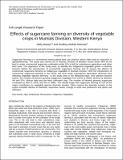| dc.contributor.author | Nelly Masayi, Godfrey Wafula Netondo | |
| dc.date.accessioned | 2020-08-17T07:15:22Z | |
| dc.date.available | 2020-08-17T07:15:22Z | |
| dc.date.issued | 2012-10-31 | |
| dc.identifier.citation | 19 | en_US |
| dc.identifier.issn | 2141-243X | |
| dc.identifier.uri | https://repository.maseno.ac.ke/handle/123456789/2134 | |
| dc.description | The article can also be accessed via URL;https://academicjournals.org | en_US |
| dc.description.abstract | Sugarcane farming is a commercial monocultural land use practice which often lead to reduction in agrobiodiversity. The study was carried out in Mumias Division of Western Kenya where 68% of the land is under commercial sugarcane cultivation while 32% is left for subsistence agriculture and other land uses. The objectives of the study were: to identify the indigenous vegetable grown in Mumias Division before the introduction of commercial sugarcane farming and to assess the effects of commercial sugarcane farming on indigenous vegetable in Mumias Division. With the introduction of commercial sugarcane farming in the 1970s, the land under subsistence agriculture declined thus affecting vegetable species diversity in the study area in the following ways: vine spinach became extinct, the number of farmers growing indigenous vegetable from 1970s to 2000s decline by between 4 and 57%. African kale was the least cultivated crop. The number of farmers growing sugarcane increased by 60% in 1970s and 6% in 1980s. The results imply that sugarcane farming is one of the major contributors to vegetable species diversity erosion. Other reasons for diversity erosion in the region included decline in livestock, expensive seeds, change in tests and preference and pests and diseases. | en_US |
| dc.publisher | Academic Journals | en_US |
| dc.subject | Agro- biodiversity, Monoculture, Indigenous Vegetables. | en_US |
| dc.title | Effects of sugarcane farming on diversity of vegetable crops in Mumias Division, Western Kenya | en_US |
| dc.type | Article | en_US |

